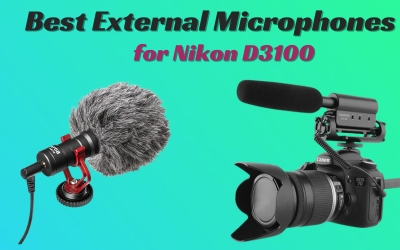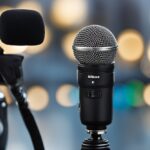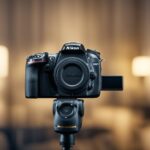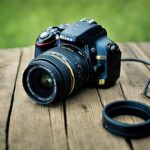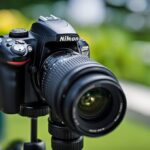If you’re looking to improve the audio quality of your Nikon D3100 videos, one of the biggest challenges you’ll face is wind noise. Even a light breeze can ruin an otherwise great recording. Fortunately, there are ways to minimize wind noise when using an external microphone with your camera.
In this article, we’ll cover some tips and techniques for minimizing wind noise on your Nikon D3100.
Table of Contents
ToggleUnderstanding Wind Noise

Characteristics of Wind Noise
Wind noise is a common problem when recording audio outdoors. It occurs when the wind hits the microphone and creates a rumbling sound that can overpower the desired audio. Wind noise is characterized by a low-frequency rumble that can be difficult to remove in post-production.
The intensity of wind noise depends on several factors, including the speed and direction of the wind, the type of microphone used, and the position of the microphone relative to the wind. The faster the wind speed, the more likely it is to create wind noise. Similarly, if the microphone is positioned directly in the path of the wind, it is more likely to pick up wind noise.
Impact on Audio Recording
Wind noise can have a significant impact on the quality of audio recordings. It can make it difficult to hear or understand the intended message, and can even render the recording unusable. Wind noise is particularly problematic for outdoor video productions, where it can be difficult to control the environment.
To minimize wind noise, it is important to use an external microphone that is designed to reduce wind noise. Additionally, you should position the microphone so that it is facing away from the wind, and use a windshield or windscreen to further reduce wind noise.
Choosing the Right Microphone
When it comes to minimizing wind noise with an external microphone on Nikon D3100, choosing the right microphone is key. In this section, we will discuss the different types of microphones, directionality and polar patterns, and microphone specifications to help you make an informed decision.
Types of Microphones
There are two main types of microphones: dynamic and condenser. Dynamic microphones are durable and can handle high sound pressure levels, making them ideal for recording live performances or loud environments. On the other hand, condenser microphones are more sensitive and offer a wider frequency response, making them ideal for recording vocals or acoustic instruments.
Directionality and Polar Patterns
Microphones also have different directionality or polar patterns, which determine how they pick up sound. The most common polar patterns are cardioid, omnidirectional, and bidirectional. A cardioid microphone picks up sound from the front and rejects sound from the sides and rear, making it ideal for recording a single subject.
An omnidirectional microphone picks up sound from all directions, making it ideal for recording ambient sound or multiple subjects. A bidirectional microphone picks up sound from the front and rear while rejecting sound from the sides, making it ideal for recording interviews or duets.
Microphone Specifications
When choosing a microphone, it’s important to consider its specifications, such as frequency response, sensitivity, and signal-to-noise ratio. A microphone with a wide frequency response will capture a wider range of frequencies, while a microphone with high sensitivity will capture quieter sounds.
A microphone with a high signal-to-noise ratio will capture less background noise, resulting in a cleaner recording.
Related Posts:
How to Minimize Wind Noise with an External Microphone on Nikon D3100
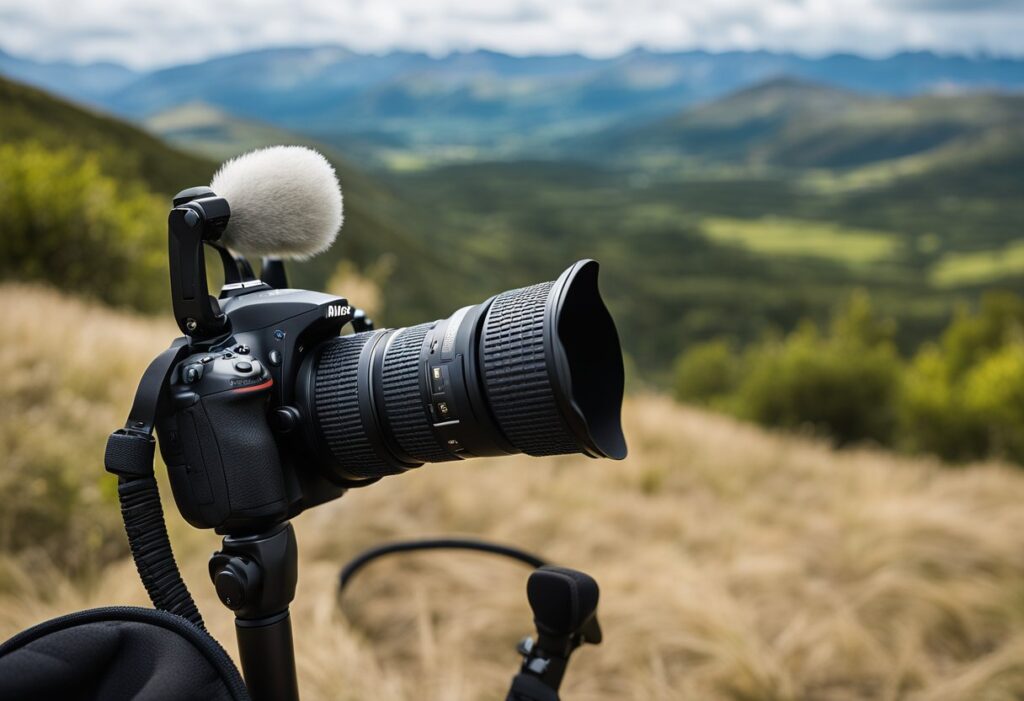
When recording audio outdoors with an external microphone on your Nikon D3100, wind noise can be a major issue. Wind can cause unwanted noise and distortion in your audio, making it difficult to hear the desired sound. Fortunately, there are several ways to minimize wind noise with an external microphone on your Nikon D3100.
Using Windshields and Windscreens
One of the most effective ways to reduce wind noise when using an external microphone on your Nikon D3100 is to use a windshield or windscreen. These accessories are designed to fit over the microphone and reduce the amount of wind that hits the microphone’s diaphragm.
There are different types of windshields and windscreens available on the market, from foam covers to furry windjammers. The type of windshield or windscreen you choose will depend on your recording environment and the level of wind noise you expect to encounter.
Optimal Microphone Placement
Another way to minimize wind noise is to place the microphone in an optimal position. Placing the microphone in a sheltered area can help reduce wind noise. For example, if you’re recording outdoors, try to find a spot that is sheltered from the wind, such as behind a building or a tree.
The distance between the microphone and the sound source can also affect wind noise. The closer the microphone is to the sound source, the less wind noise you will pick up. However, be careful not to place the microphone too close to the sound source, as this can result in distortion and other unwanted noise.
External Accessories
In addition to windshields and optimal microphone placement, there are other accessories you can use to reduce wind noise with an external microphone on your Nikon D3100. For example, you can use a shock mount to isolate the microphone from vibrations, or a low-cut filter to reduce low-frequency noise.
It’s important to experiment with different accessories and techniques to find the best solution for your recording environment. With the right combination of accessories and techniques, you can minimize wind noise and capture clear, high-quality audio with your Nikon D3100.
Related Posts:
- Eliminating background noise on Nikon D3100 with an external microphone
- Guide to Troubleshoot External Mic Problems on Nikon D3100
Post-Processing and Software Solutions
When it comes to minimizing wind noise with an external microphone on your Nikon D3100, post-processing and software solutions can be extremely useful. In this section, we will discuss some of the most effective techniques and tools for reducing wind noise in your audio recordings.
Audio Editing Software
One of the most powerful tools for post-processing your audio recordings is audio editing software. Popular options include Adobe Audition, Audacity, and GarageBand. With these programs, you can edit your recordings, apply various effects, and export them in a variety of formats.
Noise Reduction Filters
Another effective technique for reducing wind noise is to use noise reduction filters. These filters work by analyzing your audio recordings and removing any unwanted noise.
Most audio editing software includes some form of noise reduction filter, and there are also standalone plugins available for purchase.
Equalization Techniques
Equalization (EQ) is the process of adjusting the balance between frequency components within an audio recording. By using EQ, you can boost or cut certain frequencies to achieve a more balanced sound. This can be particularly useful when trying to reduce wind noise, as you can target the frequencies that are most affected by the wind.
Related Posts:
Conclusion
By following the steps outlined in this article, you can significantly reduce wind noise when using an external microphone with your Nikon D3100. Remember to use a windscreen, position the microphone correctly, and adjust the settings on your camera to minimize wind noise.
With a little bit of practice, you can capture high-quality audio even in windy conditions.
Frequently Asked Questions
What are effective methods for reducing wind noise when recording with an external microphone?
Wind noise can be a significant issue when recording with an external microphone, especially if you’re outdoors. One effective method for reducing wind noise is to use a windscreen accessory. Another method is to use a low-cut filter to reduce low-frequency noise. Additionally, you can try to position the microphone in a way that minimizes wind exposure.
Which windscreen accessories are recommended for the Nikon D3100 to cut down on wind noise?
There are several windscreen accessories that can help cut down on wind noise when recording with an external microphone on the Nikon D3100. Some popular options include the Rode Deadcat Windshield, the Movo WS1 Furry Outdoor Microphone Windscreen, and the Shure A58WS-BLK Foam Windscreen.
Can a deadcat windscreen be used on an external microphone for the Nikon D3100, and how effective is it?
Yes, a deadcat windscreen can be used on an external microphone for the Nikon D3100. Deadcat windscreens are designed to cut down on wind noise, making them a popular choice for outdoor recording. They are generally effective at reducing wind noise, but the degree of effectiveness can vary depending on factors such as wind speed and microphone placement.
What settings adjustments can be made on the Nikon D3100 to minimize wind noise during video recording?
The Nikon D3100 offers several settings adjustments that can help minimize wind noise during video recording. One option is to use the camera’s built-in wind noise reduction feature. Additionally, you can adjust the microphone sensitivity and adjust the low-cut filter to reduce low-frequency noise.
Is there a way to post-process audio to remove wind noise from recordings made with a Nikon D3100?
Yes, there are several post-processing techniques that can be used to remove wind noise from recordings made with a Nikon D3100. One option is to use noise reduction software, such as Audacity or Adobe Audition. These programs allow you to isolate and remove unwanted noise from your recordings.
How does microphone placement affect wind noise, and what are the best practices for the Nikon D3100?
Microphone placement can have a significant impact on wind noise when recording with an external microphone on the Nikon D3100. To minimize wind noise, it’s best to position the microphone in a way that minimizes wind exposure. This may involve using a windscreen accessory or positioning the microphone in a sheltered location. Additionally, it’s important to avoid handling the microphone or cable during recording, as this can produce unwanted noise.

